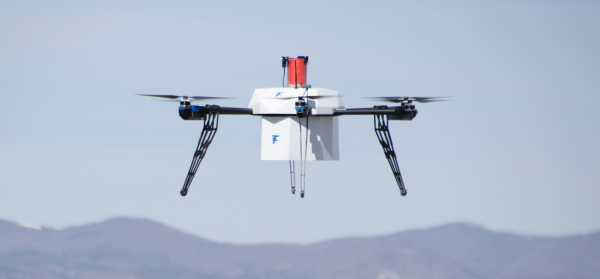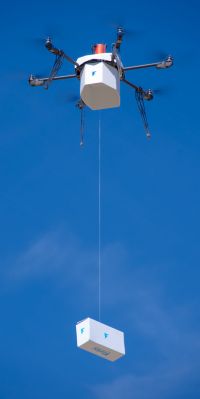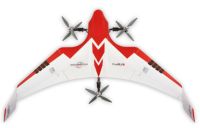Podcast: Play in new window | Download (Duration: 32:52 — 18.9MB)
 An autonomous package delivery drone, blanket COA altitude limit raised, FAA forecasts UAS sales, in U.S., states eye drone applications, NASA and AFRL developing a fully autonomous UAS, JPL applies Mars sensor technology to earth-bound drone, and the Pentagon will pair manned and unmanned jets.
An autonomous package delivery drone, blanket COA altitude limit raised, FAA forecasts UAS sales, in U.S., states eye drone applications, NASA and AFRL developing a fully autonomous UAS, JPL applies Mars sensor technology to earth-bound drone, and the Pentagon will pair manned and unmanned jets.
News
First US autonomous, urban drone delivery in Nevada
 In Episode 59 we reported that Flirtey was conducting package delivery tests in Australia. Flirtey now says they have successfully completed the first fully autonomous, FAA-approved, urban drone delivery in the United States, in an uninhabited residential setting in Hawthorne, Nevada.
In Episode 59 we reported that Flirtey was conducting package delivery tests in Australia. Flirtey now says they have successfully completed the first fully autonomous, FAA-approved, urban drone delivery in the United States, in an uninhabited residential setting in Hawthorne, Nevada.
The company successfully used a drone to deliver a package that included bottled water, emergency food, and a first aid kit. The six-rotor drone flew itself along a predetermined delivery route and lowered the package at a precise drop-off location. A Flirtey pilot and several visual observers were on standby during the delivery as a backup to the autonomous system but were never needed.
This test was completed through a partnership with the Nevada Advanced Autonomous Systems Innovation Center at the University of Nevada, Reno. Both partners are also working with NASA to develop a low-altitude air traffic management system. Additionally, Flirtey has partnered with the Nevada Institute for Autonomous Systems (NIAS) and the FAA-designated Nevada UAS Test Site.
FAA Doubles “Blanket” Altitude for Many UAS Flights
After conducting a risk analysis, the FAA has decided to raise the blanket altitude authorization for Section 333 exemption holders and government aircraft operators. Previously, the nationwide Certificate of Waiver or Authorization (COA) limited such flights to 200 feet. The new COA policy [PDF] allows commercial use to 400 feet anywhere in the country, other than in restricted airspace or where the FAA prohibits UAS operations.
Rupprecht Law’s In-Depth Analysis of the New 400ft Blanket COA for Commercial Drone Operators
Attorney Jonathan Rupprecht describes how the original blanket authorization was written to avoid a COA choke-point. However, many radio towers are between 200 and 400 feet tall, and each of these towers needed a new, 400 foot site-specific COA. This bogged down the system tremendously.
The FAA estimates that the new blanket COA will lessen the need for individual COAs by 30 to 40 percent. The blanket COA also addresses the inconsistency where recreational drone operators can fly up to 400 feet while commercial operators were restricted to 200 feet unless they obtained another COA.
Other changes to the blanket COA include see-and-avoid requirements, reporting involving certain accidents/mishaps involving UAS operations, ATC special provisions, and flight planning.
The Future of Commercial Drone Use
The latest FAA forecast shows hobbyist and commercial UAS unit sales growing from 2.5 million in 2016 to 7 million in 2020. Hobbyist purchases were 1.9 million in 2016 and the forecast is 4.3 million by 2020. Commercial sales were 600,000 in 2016 and could grow to 2.7 million by 2020.
The FAA forecast for the top five commercial drone markets:
- Industrial Inspection: 42%
- Real Estate/Aerial Photography: 22%
- Agriculture: 19%
- Insurance 15%
- Government 2%
Palm Beach County Sheriff’s Office to receive $1M in state funding for drone program
State funding for a drone pilot program at the Palm Beach Florida County Sheriff’s Office should allow them to use unmanned aircraft for “search and rescue, disaster assessment and assistance, interdiction of drug and human-trafficking activities, and situational awareness of a person whose life is in imminent danger.”
Michigan testing drones for bridge inspections
A survey by the American Association of State Highway and Transportation Officials shows that 33 states have studied or used drones, develop drone policies, or aided in drone research.
Michigan transportation officials are considering assessing bridge decks, traffic monitoring, inspecting confined spaces, and will conduct a two-year study. Minnesota tested a drone to help conduct safety inspections of bridges. Vermont is studying the use of drones to monitor river flooding and assist with road work. Massachusetts has been looking at the pros and cons of drone use.
NASA’s Traveler To Demo ‘Trustworthy’ UAS Autonomy
 NASA and the U.S. Air Force Research Laboratory (AFRL) hope to demonstrate the Traveler UAS that can autonomously plan, launch, navigate, and refuel itself. The FAA supports the idea and will use data from the program to help set future standards for UAS operations. A Traveler project demonstration flight outside of restricted airspace is planned for later in 2016. An autonomous mission without a safety pilot could take place in 2017. The demonstrations will use a modified BirdsEyeView Aerobotics FireFLY6 VTOL UAV, named “Elissa.”
NASA and the U.S. Air Force Research Laboratory (AFRL) hope to demonstrate the Traveler UAS that can autonomously plan, launch, navigate, and refuel itself. The FAA supports the idea and will use data from the program to help set future standards for UAS operations. A Traveler project demonstration flight outside of restricted airspace is planned for later in 2016. An autonomous mission without a safety pilot could take place in 2017. The demonstrations will use a modified BirdsEyeView Aerobotics FireFLY6 VTOL UAV, named “Elissa.”
Mini NASA Methane Sensor Makes Successful Flight Test
NASA’s Jet Propulsion Laboratory has successfully flight-tested a miniature, highly sensitive methane gas sensor onboard a small quadcopter. With application for pipeline inspection, the sensor is similar to the one JPL developed for use on Mars.
Pentagon touts “Loyal Wingman” for combat jets
Deputy defense secretary Robert Work says that the air force will pair unmanned F-16s with F-35s in future battles. The Air Force Research Laboratory (AFRL) is developing the autonomy algorithms needed to control the unmanned fighter jets. These algorithms would be hosted in line-replaceable units and thus, could easily be transferred between aircraft.
Video of the Week
Beachy Head in 4k by drone
Filmed at an area called Beachy Head, in Sussex, on the south coast of England. This scenic area is very similar to the white cliffs of Dover.
Mentioned
Robotics: Aerial Robotics, University of Pennsylvania
An aerial robotics course offered through Coursera. It focuses on the flight dynamics and controls for quadcopters. Enrollment is free.
UAV Propulsion Tech Representing DST Controls to Market their Gyro-Stabilized EO/IR Systems and Thermal Imagers in the US and Canada
UAV Propulsion Tech has signed a reseller agreement with DST Control to market their lightweight, high performance gyro-stabilized electro-optical systems, and small, lightweight thermal imagers into the US unmanned vehicle and manned aircraft markets. UAV Propulsion Tech is a U.S. company that markets German, Canadian, Australian and now also Swedish technology into the North American UAV market. This includes propulsion, autopilot, servo/actuator, and rescue/recovery parachute solutions.
UAV Operations: Preparing to meet the anticipated FAA knowledge test requirements for UAS Operator and/or Pilot UAS Rating (14CFR§107)
Tim Trott has written an e-book study manual in anticipation of the written test requirement for UAV operators that is included in current FAA authorization legislation. The book includes all 11 of the areas listed in the NPRM/14 CFR107 and a 50 question practice test with answer key. This material can provide preparation for the FAA test that may be coming.
New Online Registration for Commercial UAVs
Tim also tells us that as of March 31, 2016, there is a checkbox for commercial registration at registermyuas.faa.gov. Once the process is completed, a certificate number is assigned, and a certificate of registration issued for each UAS registered with the company. The new online system provides a certificate ID number instead of an N number. Those who want an N number must use the paper process.
